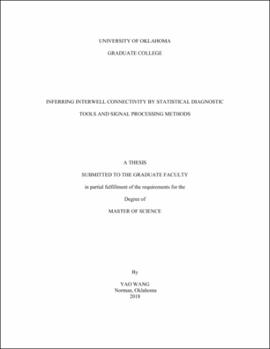| dc.description.abstract | Data mining has become increasingly crucial in deciphering reservoir dynamics. Operators currently acquire an enormous amount of data that are not effectively being used. These data contain valuable information about subsurface processes. Interwell connectivity is one of the most significant aspects of subsurface characterization that can impact a project’s success. In this thesis, I present novel techniques to quantify and monitor interwell communication by applying signal-processing methods to observed and derived well-based measurements and variables.
I construct a suite of realistic reservoir models under varying conditions involving multiple producing and water-injection wells. More than 40 static and dynamic parameters including permeability, porosity, water saturation, fluid properties and rock-fluid interaction terms are varied using experimental designs to capture realistic uncertainty. Waterflood scenarios are modeled using streamline simulation to infer injector-producer pair connectivity, pattern allocations, drainage efficiency, and their evolution. These injector-producer variables are analyzed using numerous signal-processing methods including cross-correlation, time-lag correlation coefficient, coherence, and periodogram, among others. Well variables examined involve pressure, rate, and their derivative functions.
I employed a thorough and systematic multipronged approach to decipher signals of the injector-producer well variables. At one level, the objective was to identify which variables pair provides meaningful connectivity information. Combination of well variables examined includes injector bottom-hole pressure (BHP) – producer BHP; injection rates – production rates; injector productivity index (PI) – producer PI; injector well variables – producer gas-oil ratio; and F1 – F2. Here, F1 is a producer well-variable defined as the production rate added to the product of PI and BHP of the producer, while F2 is simply the difference between injection and production rates.
The other objective was to identify which signal-processing technique(s) will be most useful to infer interwell connectivity. To verify well connectivity, I used pair-wise allocation values based on streamline simulation. Our analyses indicate cross-correlation of F1 – F2 contains most meaningful connectivity information. In this context, I have also compared the performance of our approach with the capacitance-resistance model for validation. A large dataset from the Permian Basin constituted the primary content of this investigation.
I examined and devised several signal-processing techniques of well variables to assess interwell connectivity in realistic reservoir settings. The approaches reveal new insights into determining reservoir communication metrics. The proposed methods can be easily implemented in the automated virtual flow-metering system. These methods will help identify the predominant injector-producer pairs and make operational decisions at any stage of waterflood or enhanced-recovery projects. | en_US |
